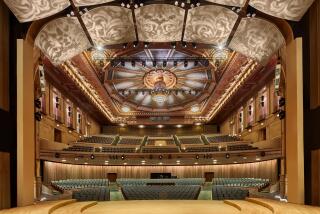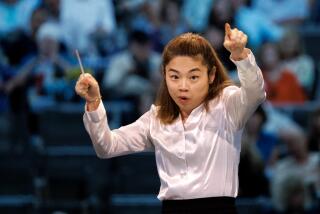Disney Hall Opens to Fanfare
- Share via
With a parade of stretch limos and the sort of celebrity buzz that Los Angeles usually reserves for Oscar night, a black-tie crowd of the powerful and socially prominent threw a Thursday night coming-out party for the city’s most highly anticipated debutante in decades: the new Walt Disney Concert Hall.
As spotlights raked the billowing exterior of architect Frank Gehry’s $274-million edifice, a glittering lineup of politicians, Hollywood players, captains of industry and cultural savants filed up a red-carpeted stairway and into the dramatically sculpted 2,265-seat hall, which has already drawn ecstatic reviews from architecture critics across the country.
For the record:
12:00 a.m. Oct. 25, 2003 For The Record
Los Angeles Times Saturday October 25, 2003 Home Edition Main News Part A Page 2 National Desk 1 inches; 50 words Type of Material: Correction
Disney Hall opening -- A report in Friday’s A section on the Thursday night gala at the Walt Disney Concert Hall mistakenly described philanthropist Eli Broad asking Los Angeles Philharmonic president Deborah Borda, “Wasn’t that a cool way to do the opening?” In fact, Borda posed the question to Broad.
For The Record
Los Angeles Times Tuesday October 28, 2003 Home Edition Main News Part A Page 2 National Desk 1 inches; 37 words Type of Material: Correction
John Hotchkis -- An article on the opening of the Walt Disney Concert Hall in Friday’s Section A misidentified John Hotchkis as Philharmonic board president. He is chairman of the board of the Los Angeles Philharmonic Assn.
Some arrivals didn’t so much sweep up the red carpet as stop dead in their tracks, in thrall to the architecture. “Gorgeous. Breathtaking. And about time,” said actress Stefanie Powers.
Indeed, in the glamorous frisson of Thursday’s gala -- the first of three such events this week -- the painful labors of the hall’s slow passage from conception to gestation to delivery seemed to be instantly forgotten.
Commissioned in 1988, after Lillian Disney made a start-up bequest of $50 million in honor of her animator-impresario husband, Walt, the hall project fell behind schedule and eventually ground to a halt in the mid-1990s.
It took a cadre of the city’s business and political movers and shakers, led by billionaire philanthropist Eli Broad, to jump-start the project and bring the hall, which some have likened to a ship under full sail, to its conspicuous berth at Grand Avenue and 1st Street.
Thursday night, as the Los Angeles Philharmonic prepared to perform a program that included “The Star-Spangled Banner,” Mozart’s Symphony No. 32 in G, Stravinsky’s “The Rite of Spring” and, fittingly, Charles Ives’ “The Unanswered Question,” a background sigh of profound relief commingled with exclamations of gratitude and joy.
“I’ve never felt like this. I’m levitating. I’m not touching the ground,” said Deborah Borda, president of the Philharmonic. “To see the love affair that people are having with this hall ... it really belongs to the city.... I’m trying not to cry, because it will ruin my makeup.”
As Gehry ascended the stairs that had taken him 15 years to build, he said, “I did it with my magic pen.” He then took a pen from his pocket and asked if anyone wanted it.
Broad, who arrived at the same time as Gehry, called the new building “a triumph for all the people in L.A.” and “the best piece of architecture in the last 50 years.”
Among the guests was a contingent of fine-arts luminaries who seemed to have caught a whiff of Disney pixie dust.
“Breathtaking. Marvelous. And he’s my buddy too,” sculptor Robert Graham said of Gehry’s work. Graham and artist Ed Moses had forgotten their tickets, but they got in anyway as Friends of Frank.
Said Moses: “You know it’s magic when you get a sense of awe. This definitely generates a sense of awe. When you walk up the stairs and look at it, it explodes like fireworks.”
Another early arrival was Philharmonic board president John Hotchkis. “This is so exciting,” he said. “There’s nothing like a delay to build up delight. And I’m glad we were delayed -- we learned so much because of it.”
Standing next to the Henry Mancini Family Staircase, singer Monica Mancini said she felt as if she were “inside a stainless steel dream. Coming here will always be an event.”
Her mother, gala Chairwoman Ginny Mancini, was no less effusive. “I feel like I did on my wedding day,” she said. “I am married to this building, to this music and to this orchestra.”
As paparazzi snapped the arriving stars, non-celebrity guests photographed one another at the top of the stairs.
Martin Bloom, an invited guest and retired investor new to Los Angeles from the Bay Area, knocked on the stainless steel exterior. “It’s not as thick as I thought it would be. I thought it would be heavier, like a bank vault,” he said.
Across the street, a dozen or so protesters carried signs reading, “For the Rich Overabundant Opulence” and “For the Poor the Boot.”
Said one protester, Alice Callaghan, director of the group Las Familias del Pueblo and a longtime advocate for the city’s poor: “So much money and talent went into creating this splendid concert hall. They could take the same amount of money and the same amount of talent and do something about people sleeping in cardboard boxes a few blocks from here.”
The protesters stood behind a phalanx of red-jacketed valets. High above the hall, helicopters swirled in the evening air that had suddenly turned cooperatively cool. At the top of the stairs, one woman draped her white fur over the railing as she watched the procession on the red carpet.
Some elderly patrons had to lean heavily on the railing as they walked up the stairs to the hall -- an indirect reminder of the hall sponsors’ hopes that the new building, along with the adventurous programming of Philharmonic Music Director Esa-Pekka Salonen, would attract new, young audiences downtown.
The hundreds of gala-goers strolled the blond hardwood floors, sipping champagne, sampling hors d’oeuvres such as salmon tartare in mini ice cream cones and gushing over the building.
Guests may have thought the finishing touches were just that -- finished -- but entrance to the Founders Room was delayed when the steel threshold popped up from the floor. Workers hurriedly put black electrical tape over it so that guests could enter with ease.
An usher, Marianna Flores -- who has worked in all the theaters of the Music Center, including the Dorothy Chandler Pavilion, Disney Hall’s predecessor -- said the new venue’s swoops and angles were “very confusing and overwhelming in the beginning, but after a while we got used to it.” Her favorite part of the evening: getting to escort stars to their seats.
It wasn’t easy to literally fill the hall. Though opening night, which was invitation only, was all but sold out by early spring, those who had paid anywhere from $1,500 to $5,000 a ticket had to be encouraged to actually take their seats. The bar closed at 6:30, the bell tolled at 6:40, and by 6:55 the tones of the ushers announcing the imminent start of the performance slid from informative to admonishing.
But miraculously enough, at 7:08, the lights dimmed and the national anthem was sung, flawlessly, by Dianne Reeves. In the darkness that followed her exit, a thousand white shirt fronts glimmered and the hall was full of the sound of 2,200 or so people holding themselves very still. Then the lights came up on the wooden bouquet of organ pipes, and from the balcony beneath it, a single violin began to play. Bach, Prelude from the Third Partita in E major.
No speeches, no rounds of applause, no testimonials, no thank yous. Just music. Everywhere music. There were violins and flutes in the rafters, trumpets and trombones in the balconies, and then the Master Chorale singing Gyorgy Ligeti’s “Lux Aeterna” from the main aisles.
At intermission, there was more champagne, more awe.
“I’ve walked through a number of times,” said Warren Beatty. “I think I knew it was as good as it gets. I’m more impressed than I thought I would be.”
Catching sight of Borda, Broad was even more succinct: “Wasn’t that a cool way to do the opening?” he shouted across the crowd.
“This house, this extraordinary house,” said Gordon Davidson, artistic director of the Ahmanson Theatre and Mark Taper Forum. “I am totally in love with it.”
And not every compliment was home grown. Ethel Decter, visiting from the Other Coast, admitted she was thrilled, but added: “This is going to give New York a headache.”
The second half of the program was “The Rite of Spring,” and four curtain calls later, it was over. The music, that is. The party was just beginning.
*
Times staff writers Ann Conway, Diane Haithman, Chris Pasles and Louise Roug contributed to this report.
More to Read
The biggest entertainment stories
Get our big stories about Hollywood, film, television, music, arts, culture and more right in your inbox as soon as they publish.
You may occasionally receive promotional content from the Los Angeles Times.












